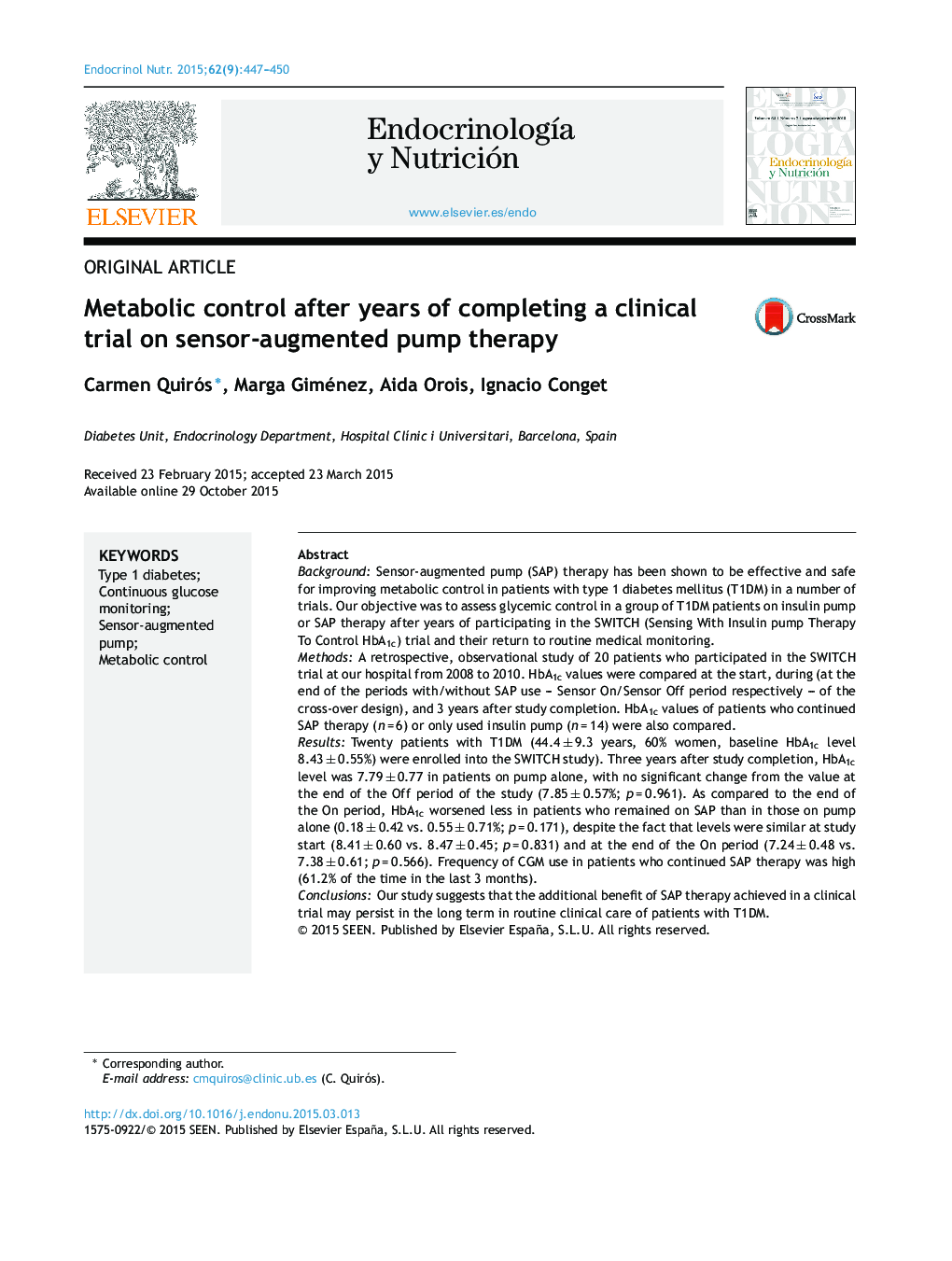| Article ID | Journal | Published Year | Pages | File Type |
|---|---|---|---|---|
| 2773335 | Endocrinología y Nutrición | 2015 | 4 Pages |
BackgroundSensor-augmented pump (SAP) therapy has been shown to be effective and safe for improving metabolic control in patients with type 1 diabetes mellitus (T1DM) in a number of trials. Our objective was to assess glycemic control in a group of T1DM patients on insulin pump or SAP therapy after years of participating in the SWITCH (Sensing With Insulin pump Therapy To Control HbA1c) trial and their return to routine medical monitoring.MethodsA retrospective, observational study of 20 patients who participated in the SWITCH trial at our hospital from 2008 to 2010. HbA1c values were compared at the start, during (at the end of the periods with/without SAP use – Sensor On/Sensor Off period respectively – of the cross-over design), and 3 years after study completion. HbA1c values of patients who continued SAP therapy (n = 6) or only used insulin pump (n = 14) were also compared.ResultsTwenty patients with T1DM (44.4 ± 9.3 years, 60% women, baseline HbA1c level 8.43 ± 0.55%) were enrolled into the SWITCH study). Three years after study completion, HbA1c level was 7.79 ± 0.77 in patients on pump alone, with no significant change from the value at the end of the Off period of the study (7.85 ± 0.57%; p = 0.961). As compared to the end of the On period, HbA1c worsened less in patients who remained on SAP than in those on pump alone (0.18 ± 0.42 vs. 0.55 ± 0.71%; p = 0.171), despite the fact that levels were similar at study start (8.41 ± 0.60 vs. 8.47 ± 0.45; p = 0.831) and at the end of the On period (7.24 ± 0.48 vs. 7.38 ± 0.61; p = 0.566). Frequency of CGM use in patients who continued SAP therapy was high (61.2% of the time in the last 3 months).ConclusionsOur study suggests that the additional benefit of SAP therapy achieved in a clinical trial may persist in the long term in routine clinical care of patients with T1DM.
ResumenObjetivosLa terapia bomba-sensor (SAP, del inglés Sensor Augmented Pump) ha demostrado eficacia y seguridad en la mejoría del control metabólico en pacientes con diabetes tipo 1 (DT1) en múltiples ensayos clínicos. Nuestro objetivo ha sido valorar el control glicémico en un grupo de pacientes con DT1 en tratamiento con bomba de insulina/SAP años después de su participación en el estudio SWITCH (Sensing With Insulin Pump Therapy To Control HbA1c) tras el retorno al seguimiento médico habitual.MétodosEstudio observacional retrospectivo que incluye todos los pacientes que participaron en el estudio SWITCH en nuestro centro entre 2008 y 2010. Se comparó la HbA1c al inicio, durante (al final de los periodos con/sin terapia SAP – periodos Sensor On/Sensor Off respectivamente del diseño cruzado-) y tres años tras la conclusión del estudio. Adicionalmente, se compararon los valores de HbA1c de los pacientes que habían continuado la terapia SAP (n = 6) respecto a los que únicamente utilizaban bomba de insulina (n = 14).ResultadosSe incluyeron 20 pacientes con DT1 (44.4 ± 9.3 años, 60% mujeres, HbA1c al inicio del estudio SWITCH 8.43 ± 0.55%). Tres años después de la conclusión del estudio, la HbA1c en los pacientes que únicamente realizaban tratamiento con bomba fue de 7.79 ± 0.77%, sin cambios significativos desde la finalización del periodo Off del estudio (7.85 ± 0,57%, p = 0.961). En comparación con la conclusión del periodo On, la HbA1c de aquellos pacientes que mantuvieron la terapia SAP al finalizar el estudio empeoró menos que aquellos que únicamente utilizaban bomba (0.18 ± 0.42 vs. 0.55 ± 0.71%; p = 0.171) aun siendo igual tanto al inicio del estudio (8.41 ± 0.60 vs. 8.47 ± 0.45; p = 0.831) como al finalizar el periodo On (7.24 ± 0.48 vs. 7.38 ± 0.61; p = 0.566). Los pacientes que seguían realizando terapia SAP tenían un elevado uso del sensor (61.2% del tiempo durante los últimos 3 meses).Conclusionesnuestro estudio apunta que el beneficio adicional obtenido por la terapia SAP durante un ensayo clínico puede persistir a largo plazo durante la práctica clínica habitual en los pacientes con DT1.
